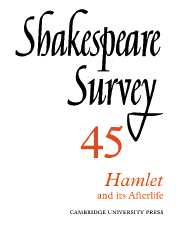Book contents
- Frontmatter
- The Reception of Hamlet
- ‘Hamlet, Revenge!’: The Uses and Abuses of Historical Criticism
- Revision by Excision: Rewriting Gertrude
- Gazing at Hamlet, or the Danish Cabaret
- ‘He’s Going to his Mother’s Closet’: Hamlet and Gertrude on Screen
- Shakespeare Rewound
- Freud’s Hamlet
- ‘Pray you, undo this button’: Implications of ‘Un-’ in King Lear
- Marx and Shakespeare
- Peter Street, 1553–1609: Builder of Playhouses
- Shakespeare Performances in England 1990–1
- Professional Shakespeare Productions in the British Isles, January–December 1990
- 1 Critical Studies
- 2 Shakespeare’s Life, Times, and Stage
- 3 Editions and Textual Studies
- Books Received
- Index
3 - Editions and Textual Studies
Published online by Cambridge University Press: 28 March 2007
- Frontmatter
- The Reception of Hamlet
- ‘Hamlet, Revenge!’: The Uses and Abuses of Historical Criticism
- Revision by Excision: Rewriting Gertrude
- Gazing at Hamlet, or the Danish Cabaret
- ‘He’s Going to his Mother’s Closet’: Hamlet and Gertrude on Screen
- Shakespeare Rewound
- Freud’s Hamlet
- ‘Pray you, undo this button’: Implications of ‘Un-’ in King Lear
- Marx and Shakespeare
- Peter Street, 1553–1609: Builder of Playhouses
- Shakespeare Performances in England 1990–1
- Professional Shakespeare Productions in the British Isles, January–December 1990
- 1 Critical Studies
- 2 Shakespeare’s Life, Times, and Stage
- 3 Editions and Textual Studies
- Books Received
- Index
Summary
There is a passage in Antony and Cleopatra (4.16) where confused composition has been suspected. In the Folio, Cleopatra greets her mortally wounded lover:
CLEO
Oh Sunne,
Burne the great Sphere thou mou'st in, darkling stand
The varrying shore o'th'world. O Antony, Antony, Antony,
Helpe Charmian, helpe Iras helpe: helpe Friends
Below, let's draw him hither.
(TLN 3011-15)The fact that twenty lines later (3035-6) Cleopatra is still urging her women to draw Antony up, as well as the repetition of Antony's 'I am dying Egypt, dying' (3022 and 3050), have caused some division among editors and scholars. John Dover Wilson sought to explain the confusion by arguing that Shakespeare's manuscript (from which most scholars think the play was set), was marked here for a cut either by the author or by the book-holder in advance of preparing the promptbook. On the other hand, Greg (who found Wilson's explanation of the causes of the confusion 'not very clear') took the apparent difficulty as a confirmation that the play was set from foul papers. He also noted the unusual spelling in the passage of Antony's name, which here almost uniquely appears without the medial h. While aware that there may be something odd about this passage, most recent editors reject theories about a false start and might well agree with Emrys Jones that since 'this is a play uncommonly concerned to render - in some of its scenes, at least - the feel of life as it is lived and especially its tendency to untidiness and anti-climax', if the passage 'seems confused and repetitive, that may be exactly what Shakespeare intended'.
- Type
- Chapter
- Information
- Shakespeare Survey , pp. 193 - 204Publisher: Cambridge University PressPrint publication year: 1992



